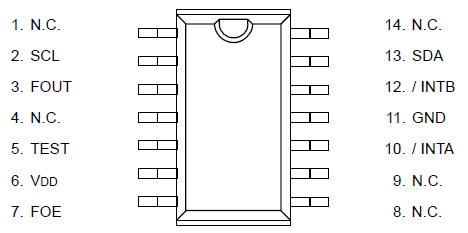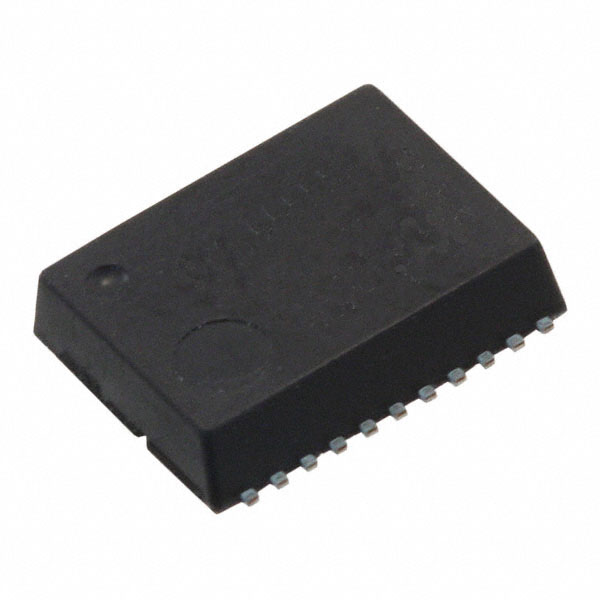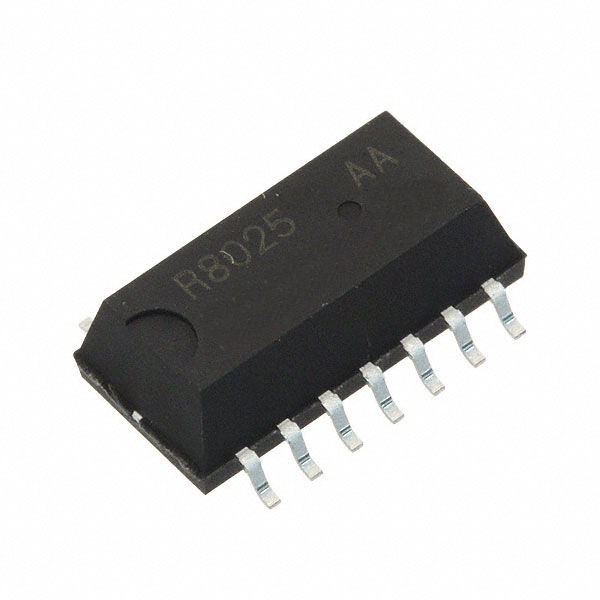Features: • Features built-in 32.768 kHz quartz oscillator, frequency adjusted for high precision (± 5 * 10−6 when Ta = +25°C)
• Supports I2C-Bus's high speed mode (400 kHz)
• Includes time (H/M/S) and calendar (YR/MO/DATE/DAY) counter functions (BCD code)
• Select between 12-hr and 24-hr clock display
• Auto calculation of leap years until 2099
• Built-in high-precision clock precision control logic
• CPU interrupt generation function (cycle time range: 1 month to 0.5 seconds, includes interrupt flags and interrupt stop function)
• Dual alarm functions (Alarm_W: Day/Hour/Min, Alarm_D: Hour/Min)
• 32.768 kHz clock output (CMOS output with control pin)
• Oscillation stop detection function (used to determine presence of internal data)
• Power supply voltage monitoring function (with selectable detection threshold)
• Wide clock voltage range: 1.15 V to 5.5 V
• Wide interface voltage range: 1.7 V to 5.5 V
• Low current consumption: 0.48 A/3.0 V (Typ.)Pinout Specifications
Specifications
|
Item |
Symbol |
Condition |
Rating |
Unit |
| Supply voltage |
VDD |
Between VDD and GND |
−0.3 to +6.5 |
V |
| Input voltage |
VI |
SCL, SDA, FOE pins |
GND−0.3 to +6.5 |
V |
| Output voltage |
VO1 |
SDA, /INTA, /INTB pins |
GND−0.3 to +6.5 |
V |
|
VO2 |
FOUT pin |
GND−0.5 to VDD+0.3 |
V |
| Storage temperature |
TSTG |
When stored separately, without
packaging |
−55 to +125 |
°C |
Description1) Clock functions
These functions enable setting, timing, and display of data including the year (last two digits), month, date, day, hour, minute, and second. Any (two- digit) year that is a multiple of 4 is treated as a leap year and calculated automatically as such until the year 2099.
. For details, see "8.2. Description of Registers".
2) Clock precision adjustment function
The clock precision of RX-8025SA can be adjusted forward or back in units of [ 3.05 ] 10.6. This function can be used to implement a higher-precision clock function, such as by:
. Enabling higher clock precision throughout the year by taking seasonal clock precision adjustments into account in advance, or
. Enabling correction of temperature-related clock precision variation in systems that include a temperature detection function.
Note: Only the clock precision can be adjusted. The adjustments have no effect on the 32.768 kHz output from the FOUT pin.
. For details, see "8.3. Clock Precision Adjustment Function".
3) Periodic interrupt function
In addition to the alarm function, Periodic interrupts can be output via the /INTA pin. Select among five Periodic frequency settings: 2 Hz, 1 Hz, 1/60 Hz, hourly, or monthly. Select among two output waveforms for periodic interrupts: an ordinary pulse waveform (2 Hz or 1 Hz) or a waveform (every second, minute, hour, or month) for CPU-level interrupts that can support CPU interrupts. A polling function of RX-8025SA is also provided to enable monitoring of pin states via registers.
. For details, see "8.4. Periodic Interrupt Function".
4) Alarm functions
This module of RX-8025SA is equipped with two alarm functions (Alarm W and Alarm D) that output interrupt signals to the host at preset times. The Alarm W function can be used for day, hour, and minute-based alarm settings, and it outputs interrupt signals via the /INTB pin. Multiple day settings can be selected (such as Monday, Wednesday, Friday, Saturday, and Sunday). The Alarm D function can be used only for hour or minute-based settings, and it outputs interrupt signals via the /INTA pin. A polling function is also provided to enable checking of each alarm mode by the host.
. For details on the Alarm W function, see "8.5. Alarm W function" and for the Alarm D function, see "8.6. Alarm D Function".
5) Oscillation stop detection function, power drop detection function (voltage monitoring function), and power-on reset detection function The oscillation stop detection function uses registers to record when oscillation has stopped. The power drop detection function (supply voltage monitoring function) uses registers to record when the supply voltage drops below a specified voltage threshold value. Use registers to specify either of two voltage threshold
values: 2.1 V or 1.3 V. Voltage sampling is performed once per second in consideration of the module's low current consumption. While the oscillation stop detection function is useful for determining when clock data has become invalid, the supply voltage monitoring function is useful for determining whether or not the clock data is able to become invalid. The supply voltage monitoring function can also be used to monitor a battery's supply voltage. When these functions are utilized in combination with the power-on reset detection function, they are useful for
determining whether clock data is valid or invalid when checking for power-on from 0 V or for back-up.
. For details, see "8.7. Detection Functions".
6) Interface with CPU
Data is read and written via the I2C bus interface using two signal lines: SCL (clock) and SDA (data). Since neither SCL nor SDA includes a protective diode on the VDD side, a data interface between hosts with differing supply voltages can still be implemented by adding pull-up resistors to the circuit board. The SCL's maximum clock frequency is 400 kHz (when VDD 1.7 V), which supports the I2C bus's high-speed mode.
. For further description of RX-8025SA, see "8.8. Reading/Writing Data via the I2C Bus Interface".
7) 32.768 kHz clock output
The 32.768 kHz clock (with precision equal to that of the built-in quartz oscillator) can be output via the FOUT pin. The FOUT pin is a CMOS pin which can be set for clock output when the FOE pin is at high level and for low-level output when the FOE pin is at low level or is left open. Note: The precision of this 32.768 kHz clock output via the FOUT pin cannot be adjusted (even when using the clock precision adjustment function).

 RX-8025SA Data Sheet
RX-8025SA Data Sheet









